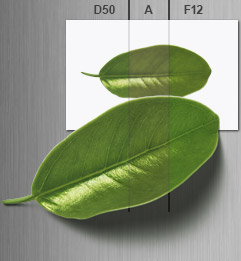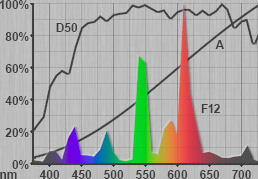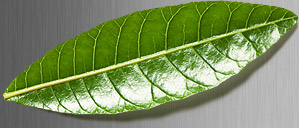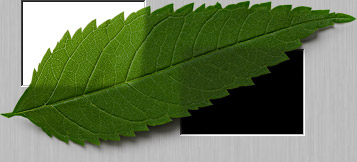Limits of color matching
Ideally it would be possible to match colors under all circumstances. In practice there are many variables that can and do affect the accuracy of color matching.
In the previous article we saw that as long as a color falls within the color gamut of a specific printer or press, it can be accurately reproduced. Unfortunately things are not always that simple.
Let's take another look at the leaf from the previous article, along with the print that we made of it. Firstly the color. It looks exactly the same. But is it the same? If we take a spectrophotometer reading of the leaf, and compare that to a reading of the print, we see that they are actually very different.

The leaf is green because of the presence of a pigment known as chlorophyll. The print is green because of a mixture of cyan, magenta, yellow and black ink – none of which contain any chlorophyll. So it is not surprising that the spectra will be different. So how can the color of the print look the same as the the color of the leaf, if they are not the same? The reason is that the human eye is not as selective as a spectrophotometer. The spectrophotometer used for the above graphs made 36 different measurements across the visible spectrum, one measurement every 10 nm. The human eye, on the other hand, can only make three measurements. It uses three different types of cone cells, each sensitive to a different part the visible spectrum, roughly in the red, green and blue areas of the spectrum. As long as the weighted sum in those three areas are the same between the print and the leaf, the eye will see the colors as being the same.
You may be wondering why it even matters if the spectrum of the leaf and the spectrum of the print is different. Surely, if the human eye cannot tell the difference, then for all practical purposes they are the same? The problem is that there is another component to color perception, and that is light. Lights also have color, but because the eye does such a good job of adapting to whatever light is dominant, most people incorrectly assume that all lights are white.


In the previous article we saw how you can match the leaf by choosing the right combination of ink from a test print. Normally you would do this under a light called D50. This light more or less approximates daylight, and it is the standard light used in the graphics industry. However, there are many other light sources and they all have different colors (and therefore spectra). For example, a regular incandescent light bulb, known as type A, radiates most of its energy in the long (red) wavelengths, and very little in the short (blue) region. A compact fluorescent lamp (type F12) is notable for having large peaks in its spectrum.
The light that gets reflected from an object is always a percentage of the light that falls on it. So when light eventually reaches the eye, its color is a mixture of the spectrum of the light source and the spectrum of the object. (Mathematically speaking, the two spectrums are multiplied together.) So in reality, the color of an object is directly affected by the light source. But because the eye automatically adapts to the light source, most of this change goes unnoticed. But not all of it.
All colors change when the light source change, and two colors that match under one light source may or may not match under another light source. If they both change by the same amount, and in the same way, they will still match. But if one change more than the other, or if they change in different ways, they will no longer match.
Now this is not to say that it is not possible to match colors, under say incandescent light. In our example it just means that we will have to find a different mixture of ink pigments to match the look of chlorophyll under that specific light. So generally, colors can be made to match under any light source, but one light source only. If you want colors to match under all light sources, you have to use exactly the same pigments. If we could somehow extract the chlorophyll pigment from a leaf, and feed it to a printer, then, and only then, would it be possible to make a print that matches the color of the leaf under all light sources.


But even if we went that far, it still would not solve all our color matching problems. So far we have only talked about diffuse reflection - the type of reflection that gives an object its color. But there is also specular (or mirror-like) reflection, where the light is reflected directly off an object without being affected by the color of the object. So depending on the viewing angles, and the position of the light source(s), the leaf may look very different. And the same thing will happen to the print. Some paper is glossy (like the paper used for magazines) and some paper is matt (like the paper used for newspapers). Furthermore, most paper is at least partially transparent. In a magazine, for example, a print may look different depending on what is printed on the other side of the page. This also applies to the object that you are trying to reproduce. If it is partially transparent, it too will change color depending on what color is behind it.
Additionally, there are several other factors that effects human perception of light and color that are beyond the scope of this short article. Some color appearance phenomena, especially those that involve higher level brain functions, are still not fully understood by scientists.
To summarize
For color management to work, it is necessary to specify the conditions under which a match is required. This means that you need to specify the light sources used for evaluation, as well as the geometry (placement) of lights. In practice, color management can be made to work remarkably well, despite all the variables. Do remember, color science is not an exact science, and never will be.